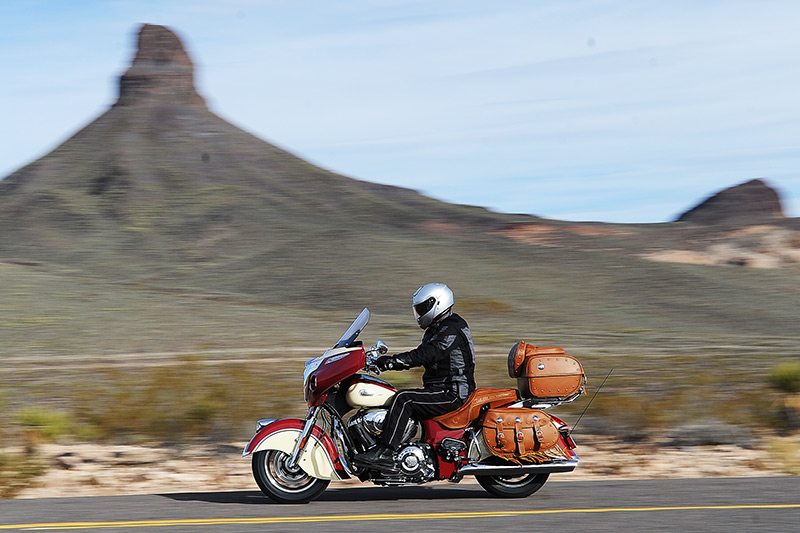
What every enthusiast thinks of today as the classic Indian motorcycle first appeared in 1940 as a radical design departure for the company’s line of Chiefs, Scouts and Fours. Chief Engineer Briggs Weaver, who was also a talented stylist, gave the bikes deeply skirted, curvaceous fenders that whimsically enveloped half of the wheels, and graced the new bikes with long, streamlined fuel tanks. On the Chief and Scouts, the cylinder fins were also sharply sculpted to flow with their sweeping lines. When production resumed after World War II, the Chief was the only pre-war model that continued until the Springfield, Massachusetts, factory closed its doors in 1953, and for many of us it’s the image of a fully dressed Chief that comes readily to mind when we think of Indian motorcycles.
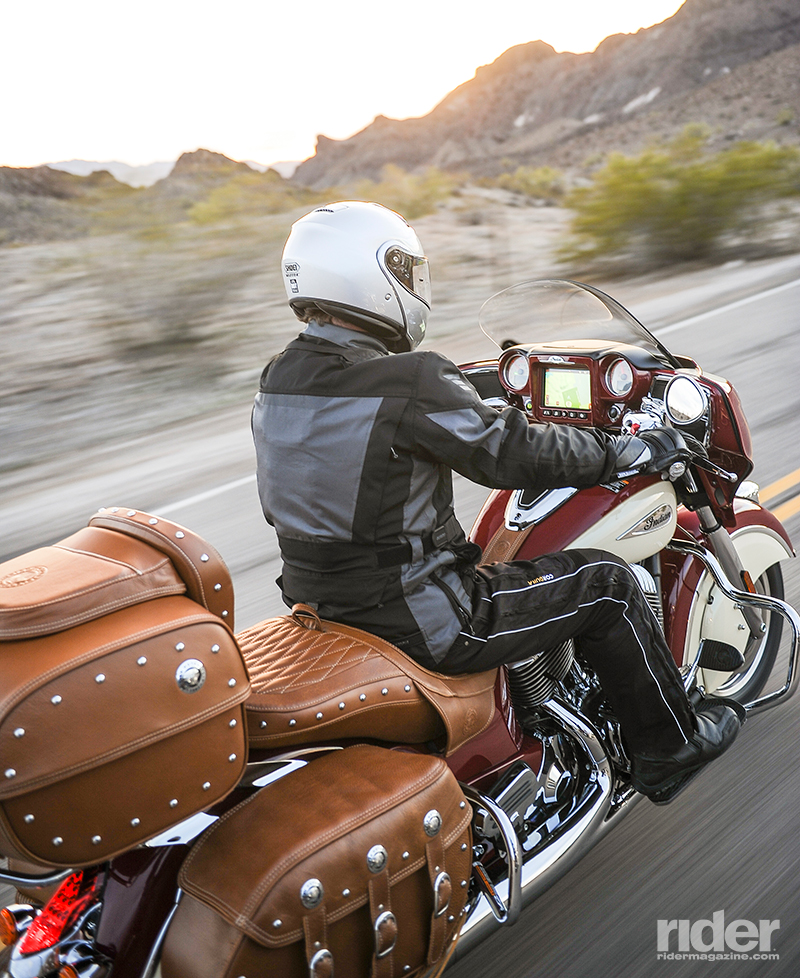
Besides the skirted fenders, central to that memory is an enormous leather solo saddle ringed with fringe and a chrome rail, and a pair of leather saddlebags adorned with straps, buckles, studs, conchos and even more fringe. Leather seats and bags were part of the Indian brand’s resurrection, too, from the Gilroy and Kings Mountain bikes c. 1999-2010 to one of the very first to return in 2014 under the new Indian Motorcycle Company brand, the Chief Vintage. Though the bags require fiddling with half-a-dozen quick-release buckles and the natural cowhide needs far more care than hard bags, many enthusiasts insist that leather and fringe are a core part of Indian’s heritage and have found novel ways to add it when it’s not included from the factory.
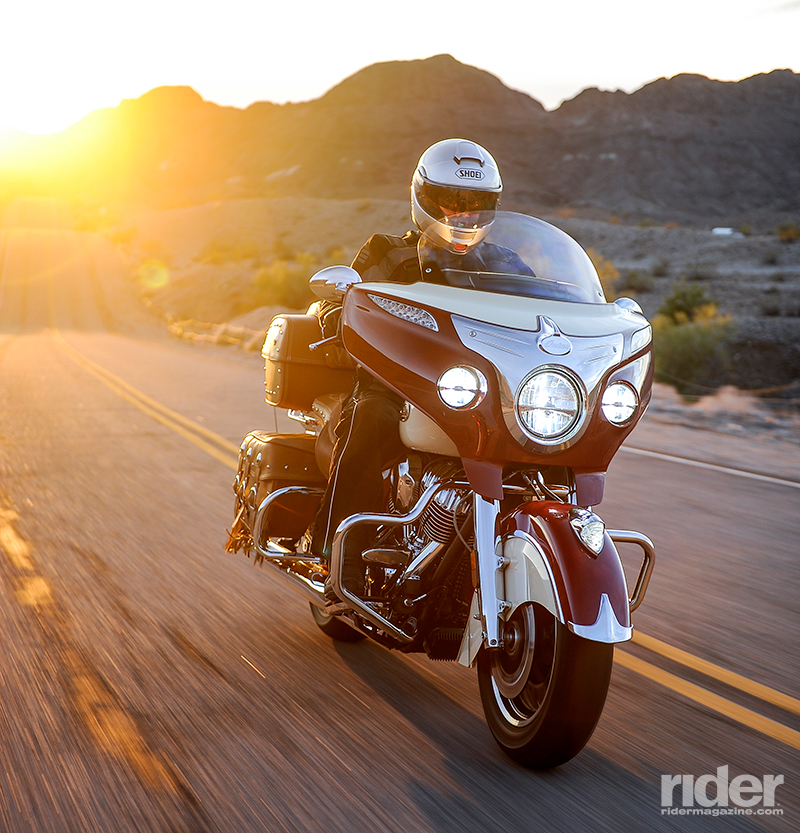
That won’t be necessary on the newest member of the Indian family, the Roadmaster Classic, since the big touring cruiser’s seats, top trunk and saddlebags are already clad in several cows’ worth of premium leather. There’s so much of it that as I write this the warm smell of Desert Tan hide is wafting through our open shop door. This is the first Indian to come with a leather top trunk, which is lined with hard plastic to keep its shape and has a built-in passenger backrest and zippered utility pocket on top. Both the trunk and bags are easily removed, and the trunk reinstalls easily enough once you get the hang of it. Saddlebags are also plastic lined (except, oddly, for the outside panels) and traditionally styled with studs, conchos, fringe and the requisite trio of straps and chrome buckles that conceal plastic quick-release buckles underneath. The package looks terrific, and is even more attractive in person on all of the bike’s color schemes: Thunder Black, Willow Green/Ivory Cream and Indian Motorcycle Red/Ivory Cream.
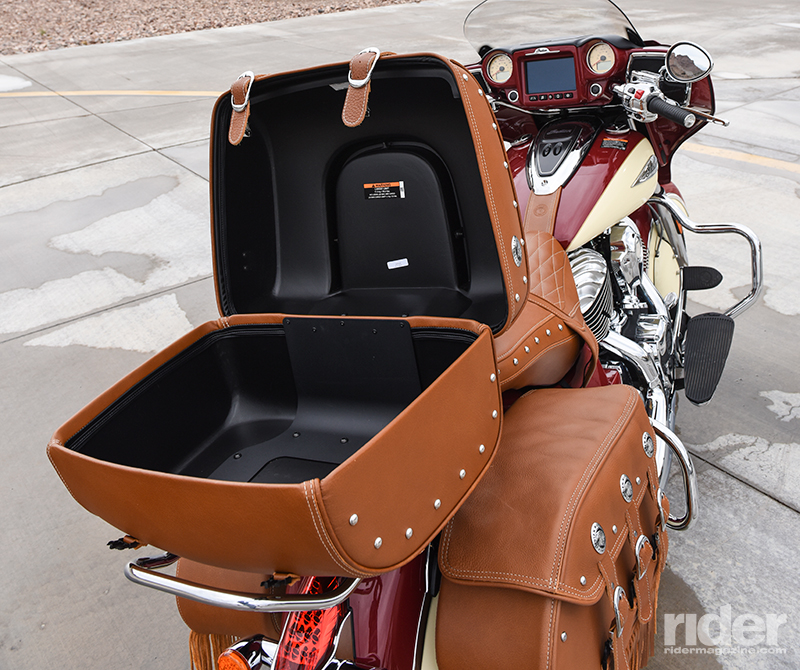
Although the top trunk easily holds two full-face helmets, none of the luggage locks, and total luggage capacity is down from 142 liters on the standard Roadmaster to 122 on the Classic. Its saddlebags are smaller, and it doesn’t come with fairing lowers (available as accessories), which have storage pockets on the standard Roadmaster. Indian says that the Classic’s leather is updated for 2017 and that it has solved the fading and discoloration issues some owners had with the leather on earlier bikes. The leather isn’t waterproof, but all of the hide on the Classic is treated to be UV, wear and water resistant, and the seats are sealed under the leather so water won’t soak through. Indian says that the look, feel and smell of the leather are important—it didn’t want a fake vinyl appearance—so you do have to expect to take care of it. Our test bike even came with a jar of leather dressing and an admonishment to use it at least monthly.
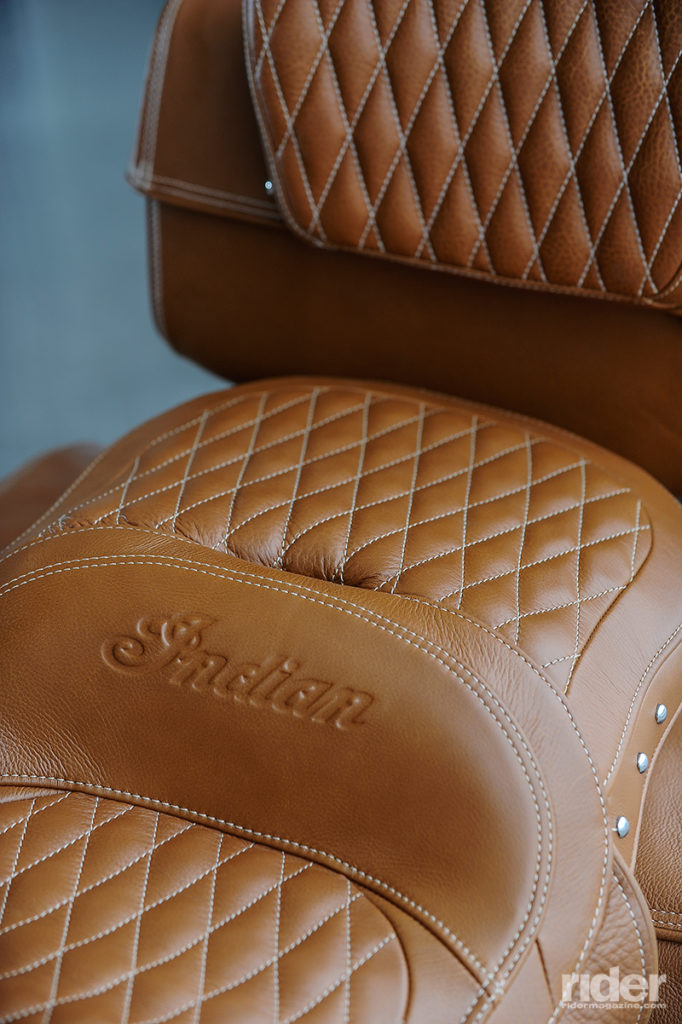
After you see it, stroke its hide and settle into the Roadmaster Classic’s plush, wide saddle, none of these limitations amount to much. As on the standard Roadmaster the rider’s seat is dished and has ample lumbar support, and the Classic’s passenger seat and backrest are so wide and comfy they rival the leather recliner in my living room, though the Classic lacks the passenger armrests (available as accessories) found on the standard Roadmaster. Both seats are heated, with high-off-low toggle switches under the left side. As we’ve indicated in several reviews, the Roadmaster is a supremely comfortable bike to ride long distances, and while the Classic sheds fairing lowers, accessory electrical outlets and rear audio speakers for its $2,000 lower MSRP, it’s chassis and running gear are identical.
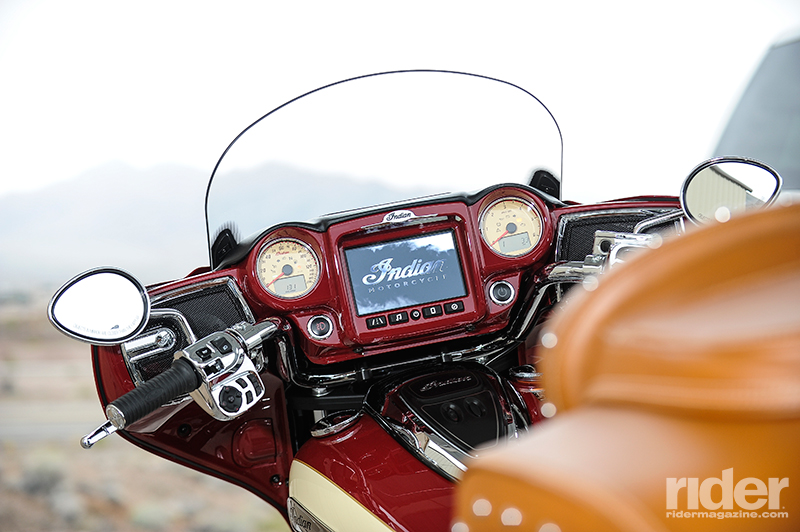
Read our Indian Roadmaster reviews and comparisons here
We’ve written reams about the Roadmaster platform in the past, and you can find in-depth reviews and comparison tests of the bike as well as a close look at its new Ride Command infotainment system on our website at ridermagazine.com. The Classic is powered by the air-cooled, 49-degree Thunder Stroke 111 V-twin also found in the Chief and Chieftain models, which cranked out 107.1 lb-ft of torque at 2,700 rpm and 76.4 horsepower at 4,500 rpm the last time we had one on the dyno (Rider, August 2015). The V-twin accelerates with gusto from just 1,500 rpm and offers plenty of power for passing and two-up riding up to redline at 5,500 rpm without any unpleasant vibration, just a satisfying bark from its big engine. Engine styling is inspired by the Powerplus V-twin from Indian’s past, with a flathead look, lots of chrome, downward firing exhaust headers and a rich, pleasing sound. The engine does radiate a lot of heat, which can get trapped by the Roadmaster’s lowers but is mostly blown away on the Classic as long as you’re moving.
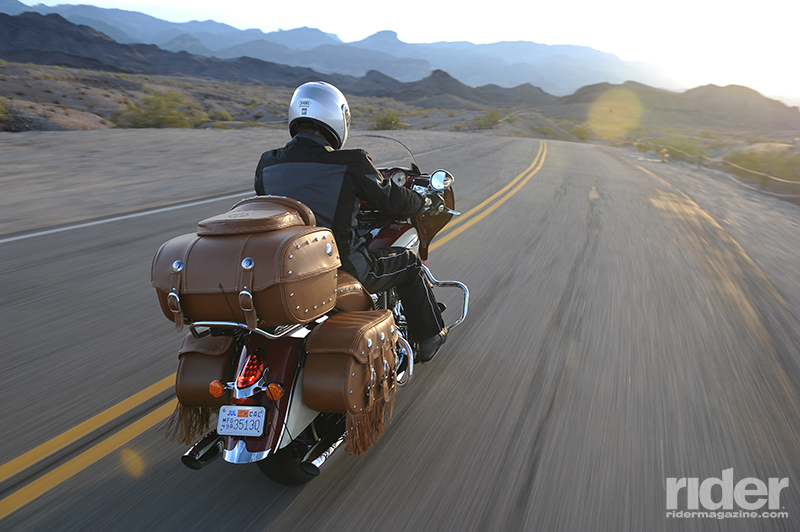
Although the Classic is still a long, heavy motorcycle, thanks to its lighter luggage and lack of lowers at 900 pounds wet it weighs 44 pounds less than the 2017 Roadmaster, which only enhances the bike’s fluid handling, good cornering clearance and powerful triple-disc ABS brakes. Ride quality from the 46mm fork and air-adjustable single rear shock is impressive—the bike simply floats over bumps and potholes that seem like they would knock your teeth out—yet even at a brisk pace it never gets out of shape on winding roads. The cockpit ensconces the rider and passenger in comfort and convenience behind a handlebar-mounted fairing with an electrically adjustable windscreen that goes up high enough to silence the wind, heated grips and seats, cruise control, adjustable passenger floorboards, keyless ignition and a tire-pressure monitoring system. Indian doesn’t use heel shifters, so the Classic’s long rider floorboards allow you to stretch your legs or bring your feet back underneath you without interference.
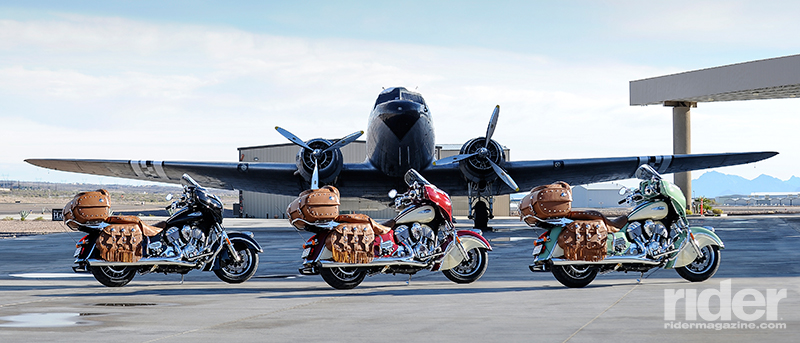
Indian’s Ride Command System (RCS) on the Roadmasters and Chieftain features a bright 7-inch touchscreen with pinch and swipe capability while wearing gloves as well as a customizable split-screen that provides turn-by-turn GPS directions, controls the 100-watt audio system with Bluetooth and USB connectivity and displays tons of vehicle and trip information. And like its siblings the Classic lights up the road ahead with bright LED head- and driving lights, not to mention that illuminated war bonnet on the front fender.
I put nearly 500 miles on the Roadmaster Classic in California and Arizona to reacquaint myself with this big platform we’ve come to admire for long rides, and to get a feel for its new leather luggage. For someone who can’t imagine doing without hard-sided, waterproof locking luggage, the Roadmaster Classic may present too many tradeoffs, even at a $2,000 and 50-pound savings. For others the Classic’s gorgeous leather luggage will be the ultimate expression of the Indian Roadmaster Americana experience.
2017 Indian Roadmaster Classic Specs
Base Price: $26,999
Price as Tested: $27,999 (two-tone paint)
Warranty: 2 yrs., unltd. miles
Website: indianmotorcycle.com
Engine
Type: Air-cooled, transverse 49-degree V-twin
Displacement: 1,811cc (111ci)
Bore x Stroke: 101.0 x 113.0mm
Compression Ratio: 9.5:1
Valve Train: OHV, 2 valves per cyl.
Valve Insp. Interval: NA (self-adjusting)
Fuel Delivery: Electronic fuel injection
Lubrication System: Semi-wet sump, 5.5-qt. cap.
Transmission: 6-speed, cable-actuated wet clutch
Final Drive: Belt
Electrical
Ignition: Electronic
Charging Output: 710 watts max.
Battery: 12V 18AH
Chassis
Frame: Modular, aluminum backbone w/ cast aluminum swingarm
Wheelbase: 65.7 in.
Rake/Trail: 25 degrees/5.9 in.
Seat Height:
Suspension, Front: 46mm stanchions, no adj., 4.7-in. travel
Rear: Single shock, air-adj. preload, 4.5-in. travel
Brakes, Front: Dual 300mm discs w/ 4-piston opposed calipers & ABS
Rear: Single 300mm disc w/ 2-piston pin-slide caliper & ABS
Wheels, Front: Cast, 3.50 x 16 in.
Rear: Cast, 5.00 x 16 in.
Tires, Front: 130/90-B16
Rear: 180/60-R16
Wet Weight: 900 lbs.
Load Capacity: 485 lbs.
GVWR: 1,385 lbs.
Performance
Fuel Capacity: 5.5 gals., last 1.0 gal. warning light on
MPG: 91 PON min. (avg) 34.1
Estimated Range: 188 miles
Indicated RPM at 60 MPH: 2,250

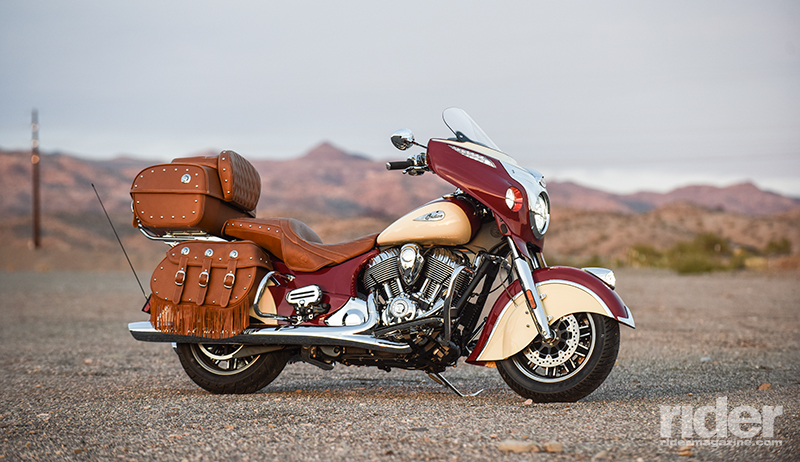

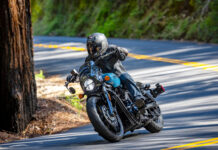





I’ve owned two of these Indians since Polaris came out with them; a 2014 Vintage (#7 the Jack Daniels bike auctioned for charity at Barrett-Jackson) and a 2015 Chieftain; and they are incredibly good bikes. Their engines are more powerful than my 2015 103 Harley Street Glide’s and their suspensions are truly the best. Even after adding a cartridge front fork & Ohlins shocks to my Harley, it still does not ride as well as the stock Chieftain or Vintage. I like my Harley; have owned a bunch of them. Rode my Ultra all the way from Ohio to Alaska (the trip of a lifetime) but the Indian is definitely a better machine. Harley now has 8 valves and that may help and they have supposedly improved their suspension (it really needed it) but Polaris nailed it with these bikes from day one.
I was extremely interested in this bike until I read that the storage is not lockable. Not too excited about that, especially when you have a $300+ riding jacket, helmet, good gloves, etc and you want to toss them in the bags while you go to eat or whatever. You are going to have to worry about stuff walking away when left unattended. It’s a damn shame, because it this the best looking tourer out on the market now.
Mike, I don’t know if that is correct. My Chieftain did not have a trunk but the two saddlebags were definitely lockable and were actuated electronically with a pushbutton on the tank. I’d check into it if I were you. BTW, the power windshield is a pretty nice feature that my Harley, GL1800, nor GS1200-A has. Those Indians are a helluva bike; I bought my Street Glide Special after a dump truck totaled my Chieftain but I wish I’d bought another Chieftain. I had to spend $4,000 on Stage 2 engine mods and $3,000 on suspension mods to get the Harley’s power & ride to an acceptable level. The Indians were perfect right out of the box.
The Roadmaster Classic’s leather luggage does not lock. The Chieftain has hard luggage (saddlebags) and a central locking system.
It looks beautiful but without locking and waterproof luggage can it truly be considered touring bike? I do like the fact that it’s lined with plastic to keep it’s form.
I have a 2014 Indian Vintage. The big has plenty of power and handles great.
When the article says that Indian solved the fading issue some riders had with all of the leather
on 2014 Vintage bikes, they should really say that Indian ignored the owners with this problem
and supplied a cheap dye to “fix” the problem. After this fix is applied, the bags faded again in a month.
The buckles on these bags wear out and can not be replaced. The buckles on my bike are on the verge of
the wind being able to open the bags. I rode my bike to Sturgis twice and was afraid most of the time that
the bags would be easily stolen. An insurance adjuster told me they had a problem with stolen bags, it takes
seconds to remove them. You can bring the bags in the hotel with you, but you’ll have a nervous breakdown
parking the bike with bags at Sturgis.
My bike has 15,000 miles on it (I own several bikes). I checked the Indian website and to add insult to injury,
the site said my bike is worth between $10,000 and $12,000 bucks. At this rate of terrible depreciation, I will
start to owe Indian money back in 3 years.
My father owned Indian Motorcycles (741 and a 340B) and I always wanted an Indian. I know a lot about Indian
history and folklore. I am 63 years old and started riding in 1969. I have owned a lot of motorcycles, one of my present
bikes is a 2007 Harley FXDC Super Glide and It’s holding it’s percentage of value better than my Indian.
When I took my bike in for a recall, an employee graciously stepped on my key fob. They told me that there was no
problem, because they would sell me another one for $120 bucks.
When riding my Indian, I still get compliments and also laughter from Harley riders when they look at the leather.
Indians moto should be a modified 1920s moto: “You can’t break and Indian, but if you do we won’t fix it.”
I’ve never had a problem with my Roadmaster that the dealer wouldn’t graciously fix. Maybe it’s your crappy attitude, bro. Go back to Harley and keep paying premium price for bikes that break down more then they ride. If Harley goes broke, it’s because of their poor reliability and corporate mentality.
I had a 48 Chief once……….My next door neighbor was trying to put an olds V8 in his boat. Boat sunk. He said I could have the motor for my 33 Ford. Ended up swapping it for the Indian. Joined the Air Force before I ever rode the Indian. Mom sold it for $400 buck, and said that’s what you owed me. So much for the 48 Indian Chief. This happened between 1954 and 1958 when I became a civilian again
Another Indian story. I had a new BSA my friend had an old Indian. We were sitting in front of the Monument dinner in Haverhill, Ma. He said lets swap bikes and ride to Salisbury Beach. He got on the BSA and took off like a flash. I went all of 5 feet on the @#$%^ Indian, and stalled it. Couldn’t get it started again. My good fiend was gone for about an hour on my BSA, The rat went all the way to the beach, knowing that I wouldn’t be able to start that miserable thang!
I bought 2017 road master classic it was black before I cranked it I told them to take it apart and paint it yellow now I have a one of a kind motorcycle the bike does get a little hot but I road it from Texas to Maine on up to Canada the bike did good . I also have a 2012 gold wing and you can’t compare them none it’s more about what you want you only live once